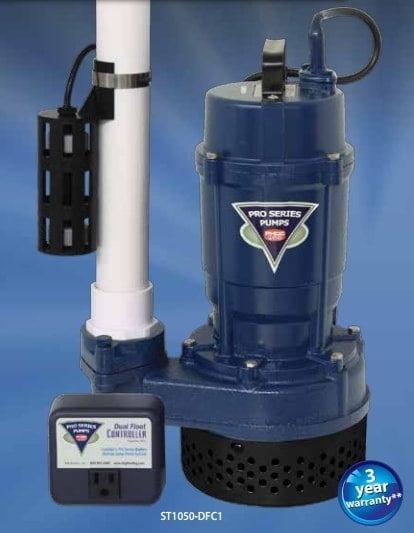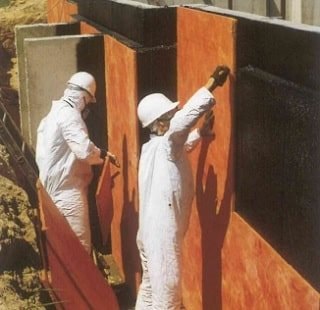The word waterproofing encapsulates many different home repair options. They range from filling cracks in basement walls to make it more difficult for water to get through to excavating around the entirety of the basement to install waterproofing membranes on the exterior walls. Regardless of the type, however, they can be divided into two basic categories: interior waterproofing and exterior waterproofing.
Each of these comes with its own set of advantages and drawbacks, so which is ideal for you very much depends on your particular home and waterproofing needs.
What is Interior Waterproofing?

There isn’t just one type of interior waterproofing. Here are some options:
Crack Repair
For minor water issues sealing the cracks through which the water is emerging from your foundation walls might be enough. In other cases, a vapor barrier placed along foundation walls can help keep moisture out. Vapor barriers are common in dealing with crawl space waterproofing as a key piece of crawl space encapsulation.
Interior Drainage Systems
When people think of large-scale interior waterproofing, however, they think of an interior drainage system. Interior drainage systems take the water that has entered the foundation or basement walls, water which would have otherwise ended up on the basement floor, and direct it to a sump pump, which pumps the water into your yard and away from your home.
To do this, a contractor will install the drainage tile along the perimeter of the basement. This will include tearing up portions of the slab floor along the exterior walls. After the drain has been dug, weep holes are drilled into the bottom of the basement wall, allowing the water to drain from the walls into the waterproofing system rather than forcing its way through the walls.
The contractor will then lay perforated piping and cover it with gravel to promote drainage. The piping will drain the water toward a sump pit. From there, the sump pump will pump the water to a designated place in the yard far enough away from the foundation.
If it is being installed in a basement, the drainage tile is then covered with concrete, restoring the slab floor.
Advantages of Interior Waterproofing
- All of the work takes place inside the home. This means no excavations are necessary in the yard. No tearing up landscaping or hardscaping. Driveways and porches are safe. That’s not to say that interior waterproofing is always quick and painless repair. If you have a finished basement and require an interior drainage system, some parts might need to be torn out in order to excavate around the perimeter walls. If you have basement water issues, however, moisture has likely damaged the carpet and drywall already.
- Because it is generally less invasive, interior waterproofing is also usually the less expensive option.
What Is Exterior Waterproofing
Exterior waterproofing is dedicated to keeping water from entering your basement or foundation walls or through your floor to begin with. This includes two distinct types of waterproofing, which can be used either separately or in combination for best results, depending upon each structure’s needs.
Exterior Drainage Systems
These drains operate much like the interior drainage system described above. The drains transport water from problem spots around your foundation to elsewhere in your yard.
Two main types are French drains and channel drains. French drains, like the interior version, consist of a perforated pipe laid in a trench with gravel or a similar material surrounding it. The waterproofing contractor will lay it at such a grade that water that enters the pipe runs away from the foundation.
Channel drains, unlike French drains, are covered only by grating. While French drains handle subsurface water, channel drains take care of surface runoff, often from concrete or other hardscaping.
These methods have the benefit of also reducing the hydrostatic pressure on your foundation walls by draining the water that would be pressing upon them.

Waterproofing Membranes
An exterior waterproofing membrane, on the other hand, directly prevents water from entering the basement walls.
Jerry’s Waterproofing uses TUFF-N-DRI waterproofing membranes. We apply the tough membrane to foundation walls for unsurpassed performance. They can work with either poured concrete or masonry block foundation walls, preventing water from infiltrating through cracks.
The system includes a drainage board to keep water away from basement walls.
Advantages of Exterior Waterproofing
The main advantage is that the water never enters your basement in the first place. French and channel drains reduce the hydrostatic pressure on the walls. This helps prevent the cracking and bowing that such forces can cause.
While there will be excavations outside, the interior of your basement will remain untouched, with no need for a sump pit and sump pump permanently occupying a corner.
So Which is Right For You, Interior or Exterior Waterproofing? It Depends
Each home and each family’s waterproofing priorities are different. Exterior waterproofing is generally seen as the more comprehensive solution. It is also the more intrusive and expensive one, however. The first step is talking to a professional who can lay out the options for your specific home.
In some cases, one option will better solve your water issues. In other cases, both are available solutions.
Once you have that information, you can weigh the benefits of each approach and decide which is right for you. If you live in Eastern Nebraska or Western Iowa, contact us at Jerry’s Waterproofing for a free estimate.



